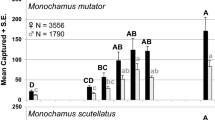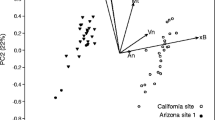Abstract
Racemicezo-brevicomin, racemic frontalin, and myrcene were released at two proportions (5∶1∶400 and 1∶1∶1), each at three levels (1 ×, 10 ×, and 100 ×) in a ponderosa pine forest in central California. The 5∶1∶400 mix was based on an estimate of the relative amounts released from a ponderosa pine under attack by the western pine beetle,Dendroctonus brevicomis. MoreD. brevicomis were trapped at a source of the three compounds released at 5∶1∶400 than were trapped at a source released at 1∶1∶1, at all three levels, but this difference was statistically significant only at the 1 × and 10 × levels. Sex ratio of trapped beetles and distribution of catch at the source of attractant and 5 m away apparently did not differ between relative release rates.
Similar content being viewed by others
References
Bedard, W.D., andWood, D.L. 1974. Programs utilizing pheromones in survey and control: Bark beetles—the western pine beetle, pp. 441–449,in M.C. Birch (ed.). Pheromones. North-Holland, Amsterdam.
Bedard, W.D., andWood, D.L. 1981. Suppression ofDendroctonus brevicomis by using a mass-trapping tactic, pp. 103–114,in E.R. Mithell (ed.). Management of Insect Pests with Semiochemicals: Concepts and Practice. Plenum, New York.
Bedard, W.D., Tilden, P.E., Wood, D.L., Silverstein, R.M., Brownlee, R.G., andRodin, J.O. 1969. Western pine beetle: Field response to its sex pheromone and a synergistic host terpene, myrcene.Science 164:1284–1285.
Bedard, W.D., Wood, D.L., Tilden, P.E., Lindahl, K.Q., Jr., Silverstein, R.M., andRodin, J.O. 1980. Field responses of the western pine beetle and one of its predators to host- and beetle-produced compounds.J. Chem. Ecol. 6:625–641.
Browne, L.E., Wood, D.L., Bedard, W.D., Silverstein, R.M., andWest, J.R. 1979. Quantitative estimates of the western pine beetle attractive pheromone components,exo-brevicomin, frontalin, and myrcene in nature.J Chem. Ecol. 5:397–414.
Cochran, W.G., andCox, G.M. 1957. Experimental Designs, 2nd ed. John Wiley & Sons, New York. 611 pp.
Cuthbert, R.A., andPeacock, J.W. 1978. Response of the elm bark beetle,Scolytus multistriatus (Coleoptera: Scolytidae), to component mixtures and doses of the pheromone, multilure.J. Chem. Ecol. 4:363–373.
Fischer, W.C., andHardy, C.E. 1976. Fire-Weather Observers' Handbook. U.S. Department of Agriculture, Forest Service Agriculture Handbook No. 494, 152 pp.
Kinzer, G.W., Fentiman, A.F., Jr., Page, T.F., Jr., Foltz, R.L., Vité, J.P., andPitman, G.B. 1969. Bark beetle attractants: Identification, synthesis and field bioassay of a new compound isolated fromDendroctonus.Nature 221:477–478.
Silverstein, R.M. 1970. Attractant pheromones of Coleoptera, pp. 21–40,in D.L. Wood, R.M. Silverstein, and M. Nakajima (eds.). Control of Insect Behavior by Natural Products. Academic Press, New York.
Silverstein, R.M., Brownlee, R.G., Bellas, T.E., Wood, D.L., andBrowne, L.E. 1968. Brevicomin: Principal sex attractant in the frass of the female western pine beetle.Science 159:889–891.
Stewart, T.E., Plummer, E.L., McCandless, L.L., West, J.R., andSilverstein, R.M. 1977. Determination of enantiomer composition of several bicyclic ketal insect pheromone components.J. Chem. Ecol. 3:27–43.
Tilden, P.E., Bedard, W.D., Wood, D.L., Lindahl, K.Q., andRauch, P.A. 1979. Trapping the western pine beetle at and near a source of synthetic attractive pheromone: Effects of trap size and position.J. Chem. Ecol. 5:519–531.
Tilden, P.E., Bedard, W.D., Wood, D.L., andStubbs, H.A. 1981. Interruption of response ofDendroctonus brevicomis to its attractive pheromone by components of the pheromone.J. Chem. Ecol. 7:183–196.
Tilden, P.E., Bedard, W.D., Lindahl, K.Q., Jr., andWood, D.L. 1983. TrappingDendroctonus brevicomis: Changes in attractant release rate, dispersion of attractant, and silhouette.J. Chem. Ecol. 9:311–321.
Vité, J.P. 1970. Pest management systems using synthetic pheromones.Contrib. Boyce Thompson Inst. 24:343–350.
Wood, D.L., Browne, L.E., Ewing, B., Lindahl, K., Bedard, W.D., Tilden, P.E., Mori, K., Pitman, G.B., andHughes, P.R. 1976. Western pine beetle: specificity among enantiomers of male and female components of an attractant pheromone.Science 192:896–898.
Author information
Authors and Affiliations
Additional information
Coleoptera: Scolytidae.
Trade names are mentioned solely for information. No endorsement by the U.S. Department of Agriculture is implied.
Rights and permissions
About this article
Cite this article
Tilden, P.E., Bedard, W.D. Field response ofDendroctonus brevicomis toexo-brevicomin, frontalin, and myrcene released at two proportions and three levels. J Chem Ecol 11, 757–766 (1985). https://doi.org/10.1007/BF00988303
Received:
Accepted:
Issue Date:
DOI: https://doi.org/10.1007/BF00988303




